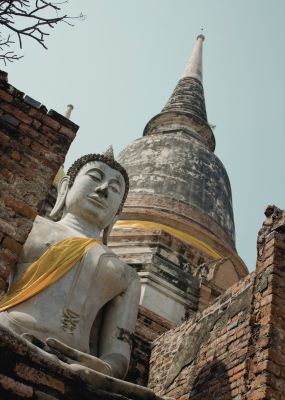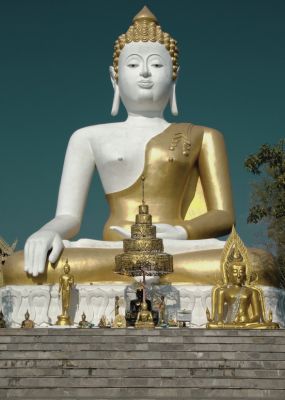Buddhism, one of the world’s oldest and most profound spiritual traditions, originated over 2,500 years ago in ancient India. Siddhartha Gautama, the founder of Buddhism, later became known as the Buddha. Buddhism offers a path to enlightenment through understanding, ethical living, and mental discipline.
At its core, Buddhism teaches the Four Noble Truths and the Noble Eightfold Path, guiding individuals toward a life free from suffering and full of compassion.
With millions of followers across the globe, Buddhism has significantly influenced various cultures and continues to inspire people with its teachings on mindfulness, inner peace, and universal kindness.
In this blog, we will explore 20 interesting facts about Buddhism that highlight its rich history, diverse practices, and lasting impact on the world.
Want to learn more about Buddhism? Check out the A Beginner’s Guide to the Principles of Buddhism.
Fact 1: The Origin of Buddhism
Buddhism traces its origins to the life and teachings of Siddhartha Gautama, who later became known as the Buddha. Born into a royal family in the small kingdom of Kapilavastu, located in present-day Nepal in South Asia, he renounced his privileged life to seek spiritual enlightenment.
Siddhartha lived a life of luxury and privilege. However, his encounters with the realities of old age, sickness, and death led him to renounce his royal life in search of a deeper understanding of human suffering. At the age of 29, Siddhartha left his palace and embarked on a spiritual quest.

He practiced severe asceticism before realizing that neither extreme indulgence nor extreme deprivation led to true enlightenment.
He then adopted the Middle Way, a path of moderation, and after years of meditation and contemplation, he attained enlightenment under the Bodhi tree in Bodh Gaya, India.
He became the Buddha, meaning “the Enlightened One,” at the age of 35.
The Buddha spent the remaining 45 years of his life teaching the principles he discovered, such as the Four Noble Truths and the Eightfold Path. His teachings emphasized the importance of wisdom, ethical conduct, and mental discipline. The historical context of his time, marked by a cultural and spiritual renaissance in India, provided fertile ground for his ideas to take root.
Buddhism initially spread through the Indian subcontinent, gaining followers from various walks of life. Over time, it expanded beyond India, reaching Sri Lanka, Southeast Asia, Central Asia, and eventually China, Korea, Japan, and Tibet.
The spread of Buddhism was facilitated by missionaries, traders, and the support of influential rulers like Emperor Ashoka, who embraced and promoted the Buddha’s teachings. This early expansion laid the foundation for Buddhism to become a major world religion, influencing countless cultures and societies throughout history.
Fact 2: The Four Noble Truths
The Four Noble Truths are the cornerstone of the Buddha’s teachings, providing a framework for understanding the nature of suffering and the path to liberation. These truths were first articulated by the Buddha during his initial sermon after attaining enlightenment, known as the Dhammacakkappavattana Sutta, or the “Setting in Motion the Wheel of Dharma.”
1. The Truth of Suffering (Dukkha)
The first noble truth acknowledges that suffering, or dukkha, is an inherent part of human existence. This suffering includes not only physical pain but also emotional and psychological distress. Life’s transient nature—encompassing birth, aging, illness, and death—ensures that everyone experiences suffering at various times.
2. The Truth of the Cause of Suffering (Samudaya)
The second noble truth identifies the root cause of suffering as craving or attachment (tanha). This craving arises from our desires for pleasure, material possessions, and even non-material things like status or recognition. It is the attachment to these desires, and the inevitable frustration when they are not met, that leads to suffering.

3. The Truth of the End of Suffering (Nirodha)
The third noble truth offers hope by asserting that it is possible to end suffering. By extinguishing craving and attachment, one can achieve nirvana—a state of liberation and freedom from the cycle of birth and rebirth (samsara).
This cessation of suffering is attainable through the disciplined practice of Buddhist teachings.
4. The Truth of the Path to the End of Suffering (Magga)
The fourth noble truth outlines the Eightfold Path as the means to overcome suffering and achieve enlightenment.
These principles guide ethical conduct, mental discipline, and wisdom, forming a holistic approach to personal development and spiritual growth.
The Four Noble Truths are fundamental to Buddhist philosophy because they offer a comprehensive diagnosis of the human condition and a practical method for transcending it. They emphasize the impermanence of all things and the importance of mindfulness and ethical living.
By understanding and applying these truths, Buddhists believe they can transform their lives, reduce suffering, and ultimately attain enlightenment.
Fact 3: The Eightfold Path
The Eightfold Path is a core teaching in Buddhism, providing a practical guide to ethical and mental development with the goal of freeing individuals from suffering and leading them towards enlightenment. The Buddha outlined this path as the way to end suffering, which is the fourth of the Four Noble Truths. The Eightfold Path is often divided into three essential aspects: wisdom, ethical conduct, and mental discipline.
1. Right Understanding (Samma Ditthi)
Right Understanding involves grasping the true nature of reality and comprehending the Four Noble Truths. It encourages Buddhists to see things as they really are, fostering a clear perception of the nature of suffering, its origins, its cessation, and the path leading to its cessation.
2. Right Intention (Samma Sankappa)
Right Intention focuses on cultivating a mindset of renunciation, goodwill, and harmlessness. It involves committing to ethical and mental self-improvement, fostering positive attitudes and intentions towards oneself and others.

3. Right Speech (Samma Vaca)
Right Speech emphasizes the importance of truthful, kind, and beneficial communication. It advises Buddhists to avoid lying, gossiping, and using harsh or divisive language, promoting harmony and understanding in their interactions.
4. Right Action (Samma Kammanta)
Right Action involves ethical conduct, encouraging actions that are wholesome and beneficial. It includes abstaining from harming living beings, stealing, and engaging in sexual misconduct. Buddhists strive to act in ways that are compassionate and respectful of others.
5. Right Livelihood (Samma Ajiva)
Right Livelihood encourages Buddhists to earn a living in a way that does not cause harm to others. This principle advises against occupations that exploit or harm people, animals, or the environment, advocating for professions that promote well-being and ethical values.
6. Right Effort (Samma Vayama)
Right Effort involves cultivating a diligent and positive mental attitude. It encourages Buddhists to prevent unwholesome states of mind, overcome negative emotions, and develop and maintain wholesome mental states, such as kindness, compassion, and mindfulness.

7. Right Mindfulness (Samma Sati)
Right Mindfulness is the practice of being fully aware and present in each moment. It involves paying attention to thoughts, feelings, bodily sensations, and the surrounding environment without judgment. This mindfulness helps Buddhists develop greater self-awareness and understanding.
8. Right Concentration (Samma Samadhi)
Right Concentration involves developing deep mental focus and meditation. It encourages Buddhists to cultivate states of meditative absorption, leading to heightened awareness and insight. This concentration helps in achieving mental clarity and tranquility.
In daily life, Buddhists use the Eightfold Path to make mindful and ethical decisions, fostering a sense of inner peace and harmony. By following the Eightfold Path, Buddhists work towards personal transformation, seeking to cultivate compassion, wisdom, and tranquility, ultimately striving to attain enlightenment.
Fact 4: The Concept of Nirvana
Nirvana is a central concept in Buddhism, representing the ultimate goal of the Buddhist path. Derived from the Sanskrit word meaning “blowing out” or “extinguishing,” Nirvana refers to the extinguishing of the fires of desire, aversion, and ignorance, which are considered the root causes of suffering. Attaining Nirvana signifies liberation from the cycle of birth, death, and rebirth (samsara) and the cessation of all forms of suffering.
Nirvana is characterized by profound peace, unconditioned happiness, and ultimate freedom. It is described as a state beyond human conceptualization, where the mind is free from all attachments and delusions. In this state, one experiences true insight into the nature of reality and abides in a state of perfect equanimity and wisdom.
Nirvana is not a place but a state of being. It is the complete liberation from suffering and the end of the cycle of samsara. It is a state of profound inner peace and freedom from all desires and attachments.

In many Western religious traditions, heaven is depicted as a physical or spiritual realm where the soul resides after death.
It is often portrayed as a place of eternal happiness, where individuals enjoy the presence of God and the company of the blessed.
The path to Nirvana involves rigorous mental and ethical discipline, including meditation, mindfulness, and adherence to the principles of the Eightfold Path. It requires individuals to cultivate wisdom, ethical conduct, and mental discipline to overcome the roots of suffering.
Attaining Nirvana is seen as the ultimate liberation, a permanent state where the individual is freed from the cycle of rebirth and the suffering it entails. It represents a complete transformation of the individual’s understanding and experience of reality.
Fact 5: The Buddhist Scriptures
Buddhism has a rich and diverse collection of scriptures that guide its followers in their spiritual practice. The Pali Canon, also known as the Tipitaka (meaning “Three Baskets”), is the authoritative scripture of Theravada Buddhism. It is considered the earliest and most complete extant record of the Buddha’s teachings. The Pali Canon is written in Pali, an ancient language closely related to the language spoken by the Buddha. It is divided into three main sections: the Vinaya Pitaka, the Sutta Pitaka, and the Abhidhamma Pitaka.
1. The Vinaya Pitaka
The Vinaya Pitaka contains the rules and regulations for monastic life. It includes guidelines for ethical conduct, disciplinary rules for monks and nuns, and procedures for managing monastic communities. These rules help maintain order and discipline within the sangha (monastic community).
2. The Sutta Pitaka
The Sutta Pitaka is a collection of discourses attributed to the Buddha and his close disciples. These teachings cover a wide range of topics, including ethics, meditation, and philosophy. The Sutta Pitaka is highly regarded for its practical advice on how to live a virtuous life and attain enlightenment. Some of the most well-known texts within this collection include the Dhammapada, the Jataka tales, and the Majjhima Nikaya.

3. The Abhidhamma Pitaka
The Abhidhamma Pitaka offers a detailed analysis of Buddhist teachings, focusing on the nature of mind and matter.
It presents a systematic and philosophical interpretation of the Buddha’s teachings, exploring the intricacies of mental states, consciousness, and the laws of nature.
In Mahayana Buddhism, additional scriptures known as the Mahayana Sutras are highly revered. These include texts like the Lotus Sutra, the Heart Sutra, and the Diamond Sutra. These sutras introduce new philosophical concepts and practices, emphasizing the path of the Bodhisattva—an enlightened being who remains in the world to help others attain enlightenment.
Tibetan Buddhism has its own rich collection of scriptures, including the Kangyur (translated words of the Buddha) and the Tengyur (commentaries by Indian and Tibetan scholars). These texts encompass a wide array of teachings, rituals, and practices specific to the Vajrayana tradition.
Fact 6: The Role of Meditation
Meditation is a cornerstone of Buddhist practice, playing a crucial role in the path to enlightenment. It is through meditation that practitioners cultivate mindfulness, concentration, and insight, which are essential for understanding the true nature of reality and overcoming the root causes of suffering.
The Buddha himself achieved enlightenment through deep meditation, and he taught various meditation techniques to help others achieve the same goal. Meditation helps to calm the mind, develop mental clarity, and foster a deep sense of inner peace.
Meditation is not just a practice confined to the cushion or meditation hall; it is meant to permeate every aspect of a Buddhist’s life. By regularly engaging in meditation, practitioners develop the ability to maintain mindfulness and equanimity in their daily activities.
This helps them respond to life’s challenges with greater clarity, compassion, and wisdom. Meditation fosters a balanced mind, reducing stress and anxiety, and enhancing overall well-being.
Fact 7: The Spread of Buddhism
Buddhism, which began in ancient India over 2,500 years ago, spread far and wide across Asia, profoundly influencing many cultures and societies. The spread of Buddhism was facilitated by the movement of monks, traders, and missionaries who carried the Buddha’s teachings to new regions.
Over time, Buddhism adapted to different cultural contexts, giving rise to various schools and practices.

The spread of Buddhism across Asia not only led to the establishment of diverse Buddhist traditions but also fostered cultural and intellectual exchanges between different regions.
Monasteries and universities became centers of learning, attracting scholars and students from various parts of the world.
The teachings of Buddhism influenced art, literature, philosophy, and even political systems, leaving a lasting legacy that continues to be felt today.
Fact 8: Different Schools of Buddhism
Buddhism has evolved over millennia, giving rise to several distinct schools, each with its unique interpretations and practices. The three major schools of Buddhism are Theravada, Mahayana, and Vajrayana. While they share a common foundation in the teachings of the Buddha, each school of Buddhism differs in their approaches, doctrines, and practices.
1. Theravada Buddhism
Theravada, meaning “Teaching of the Elders,” is the oldest surviving school of Buddhism. It is predominantly practiced in Sri Lanka, Thailand, Burma (Myanmar), Laos, and Cambodia.
Theravada emphasizes the original teachings of the Buddha as found in the Pali Canon, focusing on individual enlightenment through the practice of morality (sila), meditation (samadhi), and wisdom (panna). Monastic life plays a central role, with monks and nuns adhering to a strict code of conduct.
2. Mahayana Buddhism
Mahayana, meaning “Great Vehicle,” developed around the 1st century CE and spread to China, Korea, Japan, Vietnam, and Tibet.
Mahayana Buddhism expands on the original teachings, introducing new scriptures and emphasizing the path of the Bodhisattva—an enlightened being who chooses to remain in the cycle of samsara to help others achieve enlightenment. Mahayana practices include meditation, chanting, and rituals.
3. Vajrayana Buddhism
Vajrayana, meaning “Diamond Vehicle” or “Thunderbolt Vehicle,” emerged from Mahayana Buddhism around the 7th century CE, primarily in Tibet, Bhutan, and Mongolia.
Vajrayana incorporates esoteric practices, rituals, and the use of mantras, mandalas, and mudras. It emphasizes the possibility of attaining enlightenment in a single lifetime through advanced meditation techniques and tantric practices.
Fact 9: Buddhist Symbols
Buddhist symbols play a significant role in conveying the teachings and values of Buddhism. These symbols are often used in art, rituals, and meditation practices to inspire and remind practitioners of key aspects of the Buddha’s teachings. Here are some of the most common Buddhist symbols and their meanings:
1. The Lotus Flower (Padma)
The lotus flower symbolizes purity, enlightenment, and spiritual growth. It represents the journey of the soul from the murky waters of materialism and ignorance to the bright enlightenment of spiritual awareness

2. The Dharma Wheel (Dharmachakra)
The Dharma Wheel, or Dharmachakra, represents the Buddha’s teachings and the path to enlightenment. It is one of the oldest and most universal symbols in Buddhism.
3. The Bodhi Tree (Ficus religiosa)
The Bodhi Tree is a sacred symbol in Buddhism, representing the place where Siddhartha Gautama attained enlightenment and became the Buddha.
4. The Endless Knot (Shrivatsa)
The Endless Knot symbolizes the interconnectedness of all things and the cycle of life, death, and rebirth.
Buddhist symbols play a crucial role in conveying the teachings and values of Buddhism. They serve as visual reminders of the path to enlightenment and the principles that guide practitioners in their spiritual journey.
Fact 10: Buddhist Monastic Life
Buddhist monastic life is a commitment to the principles of simplicity, meditation, and ethical conduct. Monks and nuns, known as bhikkhus and bhikkhunis respectively, follow a disciplined lifestyle dedicated to spiritual development and the pursuit of spiritual liberation.
Monks and nuns typically wake up before dawn to begin their day with meditation and chanting. This quiet time allows them to center their minds and set a positive tone for the day ahead.
In many Theravada Buddhist countries, monks go on an alms round early in the morning, carrying their alms bowls to receive food offerings from laypeople. This practice fosters a symbiotic relationship between the monastic community and the lay followers, who gain merit by supporting the monks.
After returning from the alms round, monks and nuns partake in their first meal of the day, often in silence. Following breakfast, they engage in study and reflection on the Buddhist scriptures, deepening their understanding of the Dharma (teachings of the Buddha).

Monastic life includes performing daily chores such as cleaning the Buddhist temples, maintaining the grounds, and cooking. These activities are carried out mindfully, promoting a sense of community and responsibility.
The afternoon is often reserved for meditation, both sitting and walking, as well as additional study or teaching duties. Monks and nuns may also engage in discussions or give Dharma talks to lay visitors and fellow monastics.
The day concludes with evening chanting and meditation, providing a peaceful transition into rest. This evening practice reinforces the day’s learning and spiritual efforts.
Sacred texts play a crucial role in monastic life, guiding the monks and nuns in their quest for enlightenment and spiritual liberation. These texts include the Tripitaka (Pali Canon) and various Mahayana sutras, which are studied extensively to deepen their understanding of Buddhist teachings.
Monasticism is a fundamental aspect of Buddhism, preserving the teachings, exemplifying the Buddhist path, and fostering a symbiotic relationship with the lay community. Through their dedicated practice and service, monastics contribute significantly to the spiritual and cultural fabric of Buddhist societies in South Asia and beyond.
Fact 11: Festivals and Celebrations
Buddhist festivals and celebrations are significant events that commemorate important aspects of the Buddha’s life, teachings, and the Buddhist community. These festivals provide opportunities for Buddhists to come together, practice their faith, and celebrate their spiritual heritage.
Here are some of the most important Buddhist holidays and their significance:
1. Vesak (Buddha Day)
Vesak, also known as Buddha Day, is the most important Buddhist festival. It commemorates the birth, enlightenment, and passing away (Parinirvana) of Siddhartha Gautama, the historical Buddha. Vesak is celebrated on the full moon day in May. On this day, Buddhists visit temples, offer prayers, chant, and participate in rituals.
They often light lanterns and candles, make offerings of flowers and incense, and engage in acts of charity. In many countries, colorful processions and cultural performances are held to mark the occasion.

2. Losar (Tibetan New Year)
Losar is the Tibetan New Year, a major festival in Tibetan Buddhism that marks the beginning of the lunar calendar. It is a time for renewal, purification, and celebration. Losar usually falls in February or March. Celebrations last for several days and include cleaning homes, making offerings to deities, and performing rituals to ward off evil spirits.
Families gather to enjoy festive meals, exchange gifts, and participate in traditional dances and music. Monasteries hold special ceremonies and prayers for prosperity and peace in the coming year.
3. Obon (Bon Festival)
Obon, or the Bon Festival, is a Japanese Buddhist festival that honors the spirits of deceased ancestors. It is believed that during Obon, the spirits return to visit their families. Obon is typically celebrated in August, though dates can vary.
The festival involves cleaning and decorating family graves, offering food and prayers to the spirits, and lighting lanterns to guide the spirits back to the afterlife. Bon Odori, traditional folk dances, are performed to welcome the spirits. Floating lanterns are often set adrift on rivers and seas to symbolize the return of the spirits to the spirit world.
4. Asalha Puja (Dharma Day)
Asalha Puja, also known as Dharma Day, commemorates the Buddha’s first sermon at Deer Park in Sarnath, where he taught the Four Noble Truths and the Eightfold Path. This festival is celebrated on the full moon day of the eighth lunar month (usually July).
Buddhists gather at temples to listen to sermons, meditate, and chant. It is a time to reflect on the teachings of the Buddha and their significance in one’s life. Offerings of food, flowers, and candles are made to monks and temples.
Fact 12: The Role of Compassion
Compassion, known as “karuna” in Pali and Sanskrit, is a fundamental virtue in Buddhism and is central to the Buddha’s teachings. It is the heartfelt wish for all beings to be free from suffering and is closely linked to the practice of loving-kindness (“metta”).
Compassion is considered essential for personal spiritual development and for creating a harmonious and just society.
The Buddha emphasized compassion as a key element of the path to enlightenment. It is one of the Four Brahmaviharas, or “Divine Abodes,” which are sublime states of mind that Buddhists are encouraged to cultivate.
The other three are loving-kindness, empathetic joy, and equanimity. Together, these qualities form the foundation for ethical conduct and right intention, which are vital components of the Noble Eightfold Path.
Fact 13: Buddhism and Science
The relationship between Buddhism and modern science is one of mutual respect and collaboration. Both Buddhism and science seek to understand the nature of reality, albeit through different methodologies.
Buddhism emphasizes experiential insight and meditation, while science relies on empirical observation and experimentation. Despite these differences, there are many areas where the two fields intersect and complement each other.

Buddhism’s focus on the mind and consciousness has particularly attracted the interest of scientists, especially in fields such as psychology, neuroscience, and cognitive science.
The empirical and investigative spirit of Buddhism, as encouraged by the Buddha’s advice to “test the teachings as one would test gold,” resonates with the scientific method’s emphasis on evidence and skepticism.
Fact 14: What about God?
One of Buddhism’s fundamental aspects that sets it apart from many other religions is its lack of belief in a creator god or gods. Buddhism is generally considered a non-theistic religion that doesn’t require belief in a god or deity, but some Buddhists do believe in God.
Buddhism focuses on personal spiritual development and the pursuit of enlightenment. Buddhism emphasizes self-reliance and inner transformation.
Buddhists do not worship the Buddha as a deity. Instead, they honor and revere him as a great teacher and enlightened being who discovered and shared the path to enlightenment. The Buddha’s teachings, known as the Dharma, are the primary focus of Buddhist practice. The respect shown to the Buddha in rituals and ceremonies is a way of expressing gratitude and seeking inspiration rather than worship.
Fact 15: Karma
Karma is a fundamental concept in Buddhism, referring to the law of moral causation. The word “karma” means “action” in Sanskrit and Pali, and it signifies the actions individuals take—both physical and mental—and the results those actions bring. According to Buddhist teachings, every intentional action generates a force that will bear fruit in the future. This force shapes one’s experiences in both this life and future lives.

In Buddhism, karma is not seen as a form of predestination but rather as a dynamic process that individuals can influence through their actions.
The principle of karma underscores the importance of ethical conduct, mindfulness, and intention, emphasizing that each person is responsible for their own happiness and suffering.
Fact 16: The Dalai Lama
The Dalai Lama is the spiritual leader of Tibetan Buddhism and is considered the reincarnation of Avalokiteshvara, the Bodhisattva of Compassion. The title “Dalai Lama” means “Ocean of Wisdom,” reflecting the deep spiritual knowledge and compassion associated with this revered figure.
The current Dalai Lama, Tenzin Gyatso, is the 14th in the line of succession.
The Dalai Lama serves as the spiritual leader of Tibetan Buddhists worldwide. He provides guidance on religious practices, teachings, and the interpretation of Buddhist scriptures.
As a symbol of Tibetan Buddhism, the Dalai Lama plays a crucial role in preserving and promoting the teachings, rituals, and cultural heritage of Tibet, especially after the Tibetan diaspora.
Fact 18: Women in Buddhism
The Buddha initially hesitated to ordain women, but eventually, he allowed it due to the persistent request of his aunt and foster mother, Mahapajapati Gotami, and the support of his disciple Ananda. The establishment of the Bhikkhuni Sangha (order of nuns) marked a significant step for women in Buddhism.
The Vinaya, the monastic code of discipline, includes specific rules for bhikkhunis (nuns). Although the rules for nuns are more numerous and strict compared to those for monks, the establishment of the Bhikkhuni Sangha provided women with the opportunity to pursue a monastic life and spiritual practice.
Women have played a significant and evolving role in Buddhism since its inception. While the early Buddhist community presented challenges for women seeking full ordination and equal opportunities, the contributions and participation of women have been vital to the development and spread of Buddhism.
Today, women continue to shape and influence Buddhist practice, scholarship, and leadership across the world.
Fact 19: Buddhism and Mindfulness
Mindfulness, known as “sati” in Pali and “smṛti” in Sanskrit, is a fundamental practice in Buddhism that involves maintaining a moment-by-moment awareness of thoughts, feelings, bodily sensations, and the surrounding environment.

Rooted in the teachings of the Buddha, mindfulness is a key element of the Noble Eightfold Path and is essential for developing insight and wisdom.
The practice of mindfulness is detailed in the Satipatthana Sutta, or the Discourse on the Foundations of Mindfulness. This text outlines four primary areas of focus: mindfulness of the body, feelings, mind, and mental objects.
The Buddha taught that by observing these aspects with sustained attention and without attachment, practitioners could cultivate insight into the true nature of reality.
Fact 20: The Global Influence of Buddhism
Buddhism, originating over 2,500 years ago in ancient India, has profoundly influenced cultures across Asia and beyond. As it spread, Buddhism integrated with various local traditions, shaping and being shaped by the cultures it encountered. Today, its influence can be seen in art, literature, philosophy, and daily life across the globe.
The practice of mindfulness, deeply rooted in Buddhism, has become a global phenomenon. Mindfulness meditation is now widely practiced not only for spiritual growth but also for mental health and well-being. It has been integrated into various therapeutic practices, such as Mindfulness-Based Stress Reduction (MBSR) and Mindfulness-Based Cognitive Therapy (MBCT).

Buddhist principles of non-violence, compassion, and ethical living influence many people’s lifestyles and choices.
Vegetarianism, environmental conservation, and compassionate activism are often inspired by Buddhist teachings on the interconnectedness of all life and the importance of reducing suffering.
Buddhism’s global influence is vast and multifaceted, impacting art, literature, daily life, philosophy, and psychology. Its teachings and practices have transcended cultural boundaries, offering profound insights into the nature of existence, ethical living, and the cultivation of inner peace.
Through the integration of mindfulness, meditation, and compassionate action, Buddhism continues to inspire and transform individuals and societies worldwide, fostering a more interconnected and harmonious world.














